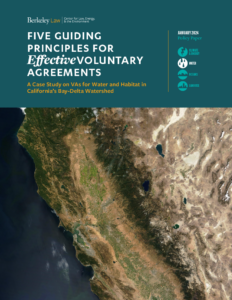Evaluating Voluntary Agreements in the Bay-Delta Watershed
by Nell Green Nylen, Felicia Marcus, Dave Owen, and Michael Kiparsky
 Updates to flow and other regulatory requirements for California’s Bay-Delta watershed are long overdue. For much of the last 12 years, state political leadership has prioritized efforts to develop voluntary agreements (VAs) with water users over completing updates to the watershed’s water quality standards. Now the State Water Resources Control Board has restarted the regulatory process and is considering what role proposed VAs will play in it. Our new policy paper—Five Guiding Principles for Effective Voluntary Agreements: A Case Study on VAs for Water and Habitat in California’s Bay-Delta Watershed—describes five principles for evaluating VAs that should guide the Board’s deliberations.
Updates to flow and other regulatory requirements for California’s Bay-Delta watershed are long overdue. For much of the last 12 years, state political leadership has prioritized efforts to develop voluntary agreements (VAs) with water users over completing updates to the watershed’s water quality standards. Now the State Water Resources Control Board has restarted the regulatory process and is considering what role proposed VAs will play in it. Our new policy paper—Five Guiding Principles for Effective Voluntary Agreements: A Case Study on VAs for Water and Habitat in California’s Bay-Delta Watershed—describes five principles for evaluating VAs that should guide the Board’s deliberations.
What are voluntary agreements?
VAs are negotiated agreements that establish pathways for regulated entities to meet regulatory requirements through alternative means. In theory, a VA can combine the protectiveness of a regulatory backstop with the creativity and flexibility of a negotiated deal to produce outcomes that are as good as, or better than, those achievable through strict application of regulatory requirements alone. VAs may be able to achieve those outcomes more quickly, with less conflict and litigation.
However, theory and reality do not always match.
A Bay-Delta case study
We examined the state’s pursuit of VAs for flow and habitat restoration to support native fish populations in California’s Bay-Delta watershed. For more than 50 years, state regulators have struggled to set and implement water quality requirements needed to adequately protect the watershed’s fish and wildlife and the people who depend upon them. Water diversions, droughts and other stressors have combined to cause long-term declines in ecosystem health in San Francisco Bay, the Sacramento-San Joaquin Delta, and the river and stream systems that feed into them. Without the flow they need to survive and thrive, native fish populations are crashing. Water quality for recreation, drinking, and other human uses has also suffered.
Despite years of apparent effort on the part of the state and other stakeholders, complex and politically challenging discussions have not yet yielded fully developed or adequate VAs capable of achieving key regulatory goals in Bay-Delta watershed.
Key takeaways from the case study
We find that leading with VAs as a solution for balancing human and environmental needs for water—rather than first, or simultaneously, pursuing a regulatory pathway to achieve key biological goals—is a perilous strategy that risks continued environmental degradation and legal noncompliance.
While VAs can produce win-win solutions, they cannot fully substitute for regulatory requirements. The state has a clear legal obligation to develop and implement water quality standards sufficient to reasonably protect the beneficial uses of a waterway, including fish and wildlife uses. These standards establish the basis for measuring the adequacy of VAs meant to achieve that protection.
The absence of a strong regulatory foundation undercuts water users’ incentives to make robust voluntary commitments. A basic premise of negotiation is that all parties need to understand their alternatives to a negotiated solution. If an adequate default regulatory framework does not exist—which may happen if the state puts all its eggs in the VA basket—the state’s primary alternative to an agreement is maintaining the problematic status quo while it belatedly begins to develop direct regulation, resulting in further delay. Meanwhile, for entities that benefit from the status quo, the alternative is continuing to negotiate indefinitely, with the current under-protective regime left in place.
A default implementation pathway for regulatory requirements is also needed to ensure that those who are not bound by VAs contribute their fair share to meeting the goals theoretically embodied by VAs.
Guiding principles for voluntary agreements
Using the Bay-Delta watershed as a case study, we define five simple and interrelated principles to guide the appropriate use and evaluation of VAs:
-
- The state must establish a strong regulatory foundation for VAs.
- VAs must achieve comparable environmental outcomes to the outcomes default regulatory requirements are expected to produce.
- VAs must articulate clear, specific biological goals and measures of success.
- VAs and actions taken under them must be well-supported by the best available scientific information.
- VAs must include robust and transparent accountability mechanisms.
Adhering to these principles will help close the gaps between the asserted potential and the actual performance of VAs. We expect the principles to be relevant whenever VAs are contemplated as an option for creatively implementing regulatory requirements.
Funding for this project was generously provided by the Water Foundation.
Featured image: Satellite image of California, Jacques Descloitres, MODIS Rapid Response Team, NASA/GSFC.






Reader Comments